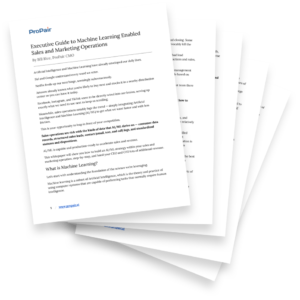What's in this article?
For sales directors, managing the sales process can be an enigma. Between juggling the human elements of your sales team, market changes, and the technical aspects of your system, it’s challenging to pinpoint exactly what needs to improve for smoother sales.
As inflation remains high and consumers continue to hesitate in making purchase decisions, your flow of new leads may have slowed. Take advantage of this time to revamp your sales process.
When consumer demand begins to increase again, you’ll be set up to scale your business and grow efficiently.
That’s why we’ve broken down our 90-day plan to improve your sales process to uplevel your sales operation.
We also share the simple ways new AI technologies can be added to your sales process for almost instant gratification that you might be surprised is so accessible.
Schedule a free demo with ProPair to learn about using AI to boost your sales process now.
How the 90-day plan to improve your sales process benefits business
The 90-day plan to improve your sales process is a concrete way to break down what is needed to improve sales and then take actionable steps to make those improvements and measure their effectiveness within a set amount of time.
It ensures efficiency, focus, and responsible use of resources. You’ll gain control of the sales process, manage time and resources well, empower your team, and grow your capabilities to ultimately meet your goals and scale your business.
Our sales process plan breaks down into three months that are hyper-focused in the following areas:
- 30 days: Assessment, exploration, and goal setting
- 60 days: Implementation, tracking, and training
- 90 days: Reaching goals, scaling, and adjusting
Let’s dig into how the plan works, including our 90-day plan to improve your sales process example and checklist to help you get started.
Dive deeper with The Ultimate Guide to Building and Maximizing Your Sales Process + How AI Will Help
30 days: Assessment, exploration, and goal setting
1. Know where things stand now
Before it’s time to jump into changing your sales process, understand your current situation. Get a baseline to measure performance improvements and gain awareness of your current strengths and weaknesses.
This involves a blend of assessing your current lead and sales data, as well as touching base with those involved with your sales process to assess anecdotal experiences.
Take this opportunity to do the following:
- Note all tools, software, technologies, and support you use within your sales process. This includes your CRM system and other tools integrated with it, as well as the vendor expertise you rely on, how you source leads, and any other external support you use.
- Note what team members and departments currently access and use these resources.
- Assess current sales performance markers and KPIs. What goals have you been working toward and how likely are you to achieve them?
- And then get into a little more detail by looking at your actual leads. What is their quality, conversion rate, and how does your sales team feel about working with them?
- Gain feedback from teams to understand how they feel about the current sales process and gain an understanding of their nuanced, day-to-day experiences.
- Explore the competitive landscape to understand what your competitors are doing to reach and engage leads. How could you do it better?
You’ll build on this knowledge as we continue through the 90-day plan. It gives you a foundation to determine weak points and solidify the strengths of your sales process.
Read more: 10 Common Underperforming Sales Process Problems + How to Solve Them with AI
2. Assess new opportunities
Now that you know where you stand, you want to think about where you’d like to go next. What else is possible?
Explore your options to understand the potential of optimizing your sales process. This involves researching the resources available that support or even eliminate your current weaknesses.
It’s a crucial step because consumer behaviors rapidly change and our digital landscape is ever-evolving. Assessing new ways to support how you grow and stretch to improve your business will boost your sales process and ultimately put you ahead of the competition.
Artificial intelligence offers several essential tools that many sales operations are beginning to adapt. As you consider your options, learn what is offered with AI for sales.
Get our free download to learn the top 5 ways to boost sales with AI.
Consider these AI technologies to improve your sales process
- Predictive analytics, lead scoring, sales agent matching, and lead prioritization to enhance all aspects of lead management with data-driven, AI-powered inputs.
- Conversational AI using chatbots or virtual assistants to communicate with and filter leads with sentiment analysis and Natural Language Processing (NLP).
- Personalization and segmentation to more easily connect with leads with a tailored approach through segmenting them into targeted groups and automatically personalizing touchpoints to match their status.
- Automation to simplify repetitive tasks like data entry, follow-ups, and specific touchpoints that free up the sales team to focus on higher-level tasks.
Read more about AI for applications within the sales process here:
- Top 10 Emerging Trends in Sales Lead Management Systems for 2023
- Guide to Predictive Lead Scoring and Why Most Lead Scoring Models are NOT Predictive
- These 10 Machine Learning Applications are Making a Big Impact on the Modern Lead Distribution System
3. Set goals
With new possibilities in mind, it’s time to commit to new goals you want to reach. How do you want your business to improve and grow?
You might not know exactly how you’ll reach these new goals at this phase, but you have an understanding of what is possible and can decide what is worth striving for to improve your sales process and ultimately improve your business.
Below are some examples of sales process goals to set at this point:
- Increase conversion rates
- Reduce cost per acquisition
- Increase number of qualified leads
- Increase lead engagement
- Improve sales agent productivity
- Increase upsells and cross-sells
- Improve customer retention
- Increase annual sales
- Increase capacity to scale
Get specific with your goals. By what percentage do you want to improve, increase, or decrease in these different areas?
60 days: Implementation, tracking, and training
4. Implement new solutions
To reach the new sales process goals you’ve set, you’ll need to implement the new resources you researched in the first 30 days.
After speaking with software providers, viewing demos, and landing on the solutions you’d like to try, you’ll start the next month by getting these new resources set in place.
This involves:
- Ensuring new tools can integrate with your current CRM system or other lead management software.
- Balancing system changes without interrupting the current daily sales operation.
- Ensuring lead and sales data remains secure and intact through the transition.
- Openly communicating with all team members involved to stay on the same page and manage the transition smoothly.
Read more:
- The Full Sales Process Tech Stack You Need to Close More Deals with Inbound Leads
- Your step-by-step guide to implementing AI/ML tools to impact sales
How do AI technologies factor into this phase?
You might think adding AI for sales requires custom models to be built by advanced data scientists, as well as a hefty investment of time and money. But there are actually production-ready AI models that are already built and ready to plug into your sales process.
By working with a trusted AI provider like ProPair, you can add AI capabilities to your sales process in a matter of days (rather than months or even years).
ProPair takes the following steps to integrate AI for sales operations:
- Standardizes your data
- Customizes production-ready machine learning models
- Helps you implement very specific use cases for AI
- Measures, optimizes, and expands the capabilities of AI within your sales process
5. Track and measure new solutions
Once new structures are in place to support your new sales process goals, it’s important to immediately begin tracking and measuring sales process performance.
Based on the goals you set, what KPIs do you need to measure to track how likely you are to reach the goals? KPIs could include the following:
- Conversion rates
- Lead response time
- Cost per acquisition
- Sales cycle length
- Sales agent activities
- Lifetime customer value
- New leads in pipeline
- Number of qualified leads
- Average age of leads in pipeline
Sales Process Secrets: 12 Insider Tips to Create a High-Performing Sales Operation
6. Work on internal training and communications
Navigating any transition requires clear communication with all involved.
To maximize the effectiveness of the time, effort, and resources you’re investing in improving the sales process with this 90-day plan to improve your sales process, ensure that all relevant team members are clued in and trained up on the changes.
Consider these steps at this phase of the plan:
- Make sure all stakeholders have buy-in to the changes from the beginning and throughout the transition for the best chance of ongoing agreement and success.
- Provide visibility and hands-on training for new software or changes to your CRM system and other lead management tools.
- Set clear expectations for your various departments as to how the changes to the sales process and overall sales goals affect their roles in the company.
- Motivate internal teams to get on board with the changes and work toward new goals by providing them with all of the context and support they need to do so.
90 days: Reaching goals, scaling, and adjusting
7. Make adjustments to stay on track toward goals
You have all of the structures in place to improve your sales process and are likely beginning to see changes. Now you need to focus on ensuring your sales strategies are on track to achieve your goals.
- Analyze metrics and data to determine where you need to improve and what’s working well.
- Refine your process to work toward eliminating weaknesses even further.
Using tools like predictive analytics can help you make informed predictions about potential outcomes to allow you to better prepare and plan for hitting short and long-term goals.
8. Begin to scale new solutions to meet goals
As you find that various aspects of your sales process have begun to improve, you can now look for ways to make those aspects more resilient and flexible so that they continue to do well as your business scales.
Look for any areas where your sales performance is limited, where bottlenecks occur, or where measurements aren’t quite where you want them.
Work with your software providers to understand their full capabilities to know whether they can expand with you or you’ll need to add additional support with growth.
Download our free aged leads AI guide to maximize the leads you’ve already invested in.
9. Reset expectations
At this point in the 90-day plan to improve your sales process, improvements are sticking and your sales process is upleveling. This is an important time to revisit expectations and clarify any changes with the team.
This is another reason it’s important to incorporate continuous training, open communication, and visibility into various metrics and tools for your sales team. It makes shifts and changes smoother to navigate by empowering your team with the support they need to help you reach larger business goals.
Top 20 Ideas for Improving the Sales Process to Spark Change and Growth Within Your Business
Get started with our checklist and example 90-day plan to improve your sales process
We’ve outlined an actionable example of the steps you can take to begin and successfully complete your own 90-day plan to improve your sales process.
Use our checklist for each phase of the plan to stay on track toward improving your sales process with clarity and impact.
When you break it down, it’s less than a dozen steps that translate to major improvements in your sales process that will increase revenue and decrease ROI.
90-day plan example for the first 30 days
1. Assessment of current sales process
Run through this list for a full assessment:
- What is your CRM system and what capabilities within it do you use?
- What software is integrated into your CRM system for lead management, sales enablement, lead sourcing, marketing, etc.?
- What team members and departments are involved in the sales process (sales, marketing, finance, product development, etc.)?
- What goals have you been working toward and where do KPIs stand now?
- How are leads performing according to various metrics and your team’s feedback?
- What are your competitors doing to reach and engage leads?
Increase conversions from the start with AI lead assignment. Download our free guide to learn more.
2. New opportunities to explore
Of the below areas, which ones could you strengthen and which ones could improve with the addition of AI technologies to boost your sales process?
- Data analysis and reporting (predictive analytics)
- Lead scoring and qualification (predictive lead scoring)
- Sales agent matching and lead distribution (AI-powered lead routing)
- Lead prioritization and lead nurturing (AI-powered lead prioritization)
- Touchpoints and follow-ups with leads (conversational AI)
- Personalized lead journeys and communications (personalization and segmentation)
- Sales agent productivity (automation)
2023 Perspective on Harnessing the Power of AI for Lead Distribution
3. Setting new goals
Set specific and actionable goals around these crucial areas of the sales process:
- Lead quality
- Conversions
- Sales agent performance
- Team training
- ROI and revenue
- Resource allocation
90-day plan example at 60 days
4. Implement new solutions
Put new solutions in place by taking the following actions:
- Integrate new tools with your current CRM system or other lead management software
- Work with a trusted AI provider to quickly add new capabilities of AI for sales
- Maintain current daily sales operations throughout system changes
- Keep lead and sales data secure and intact during the transition
- Openly communicate with all internal teams for a smooth implementation
The Sales Funnel: How to Optimize Lead Management and Improve ROI using AI
5. Track and measure new solutions
Measure KPIs that help you assess whether you’re on track to meet your new sales process goals. Ensure that data like the following is being tracked, measured, and analysed depending on which metrics match your sales goals:
- Conversion rates
- Lead response time
- Cost per acquisition
- Sales cycle length
- Sales agent activities
- Lifetime customer value
- New leads in pipeline
- Number of qualified leads
- Average age of leads in pipeline
6. Train and communicate with internal teams
Ensure the success of new implementations by taking the following steps:
- Secure and maintain stakeholder buy-in
- Provide visibility and hands-on training for new software and resources
- Set clear expectations for internal teams as to how to reach new sales goals
- Empower teams to work toward sales process improvements with the right context and support
90-day plan example at 90 days
7. Make adjustments to stay on track toward goals
Ensure sales strategies are on track using these steps:
- Analyze metrics and data to determine where you need to improve
- Note what’s working well so you can maintain it or continue to foster growth
- Refine your process to work toward eliminating weaknesses even further
- Make the most of AI for sales like predictive analytics for informed predictions about potential outcomes
8. Begin to scale new solutions to meet goals
Make your sales process resilient, flexible, and positioned for growth with these steps:
- Continue to eliminate bottlenecks and limitations
- Address KPIs that aren’t measuring up
- Work with software providers to understand the full capabilities of their support
- Add additional resources where needed
9. Reset expectations
Continue to assess, communicate, and train for the best possible sales process. Don’t forget these steps:
- Revisit expectations and clarify any changes with the team
- Provide visibility into data and metrics to empower your team to stay on track
- Provide ongoing support that allows all involved to work together toward business goals
- Offer continuous training to maximize the capabilities of your tech stack and team
Kickstart your 90-day plan to improve your sales process with AI
Whether you’re ready to dig into a full 90-day plan to improve your sales process or not, there are improvements you can make to your sales process that will significantly impact your business overall.
As you’ve noticed, we explain how AI for sales can be incorporated into your current lead management system to make these improvements easy and efficient.
Manage data like never before and automate aspects of the sales process that cause frustration and confusion.
With ProPair’s AI platform, we provide AI models that can plug into your current system. We also work with you to ensure wide-ranging AI capabilities work for the specific use cases you need to improve your business.
Schedule a free ProPair demo to see how AI for sales enhances business in a matter of days.

How does AI increase sales?
Download our executive guide to understand the current state of AI and machine learning. We’ll show you how innovative sales and marketing organizations use it to get ahead of their competition.



